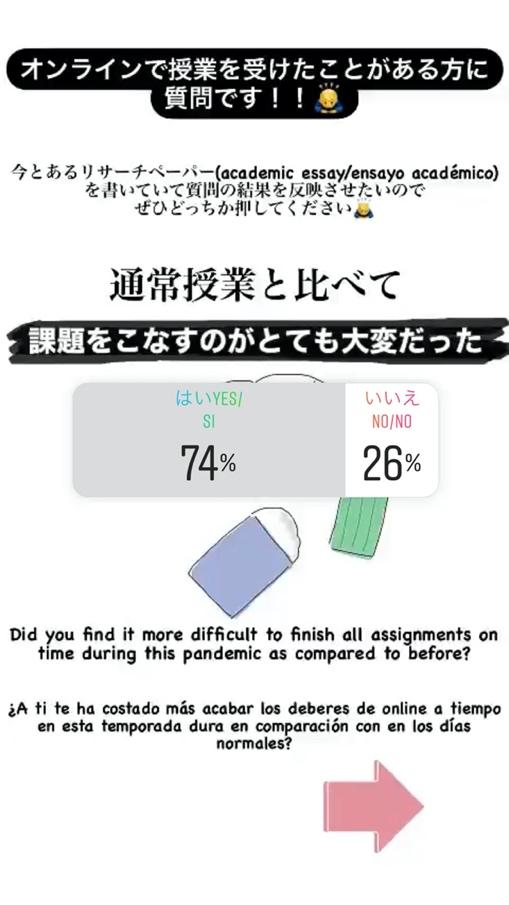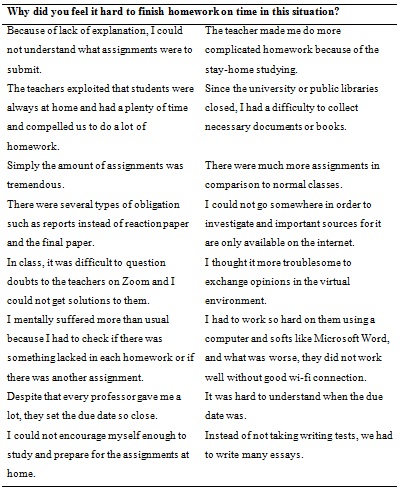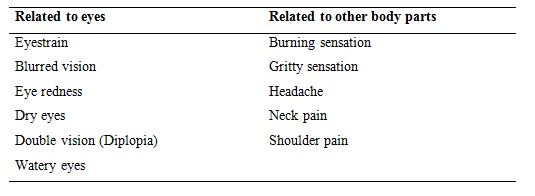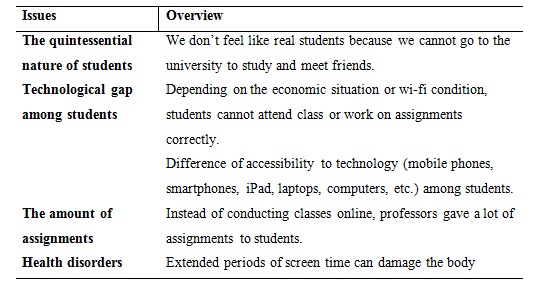Keita Kuramitsu
Kuramitsu, K. (2020). How to coexist with technology in online educational contexts: A student perspective. Relay Journal, 3(2), 209-220. https://doi.org/10.37237/relay/030206
[Download paginated PDF version]
*This page reflects the original version of this document. Please see PDF for most recent and updated version.
Abstract
This reflection is based on what the author experienced during his first semester of online classes. During the pandemic, many professors have taken it for granted that they should be providing more online materials in lieu of normal in-person classes. However, they are not conscious enough of the disadvantages of excessive computer usage. Students are struggling with three main issues; accessibility to class, the amount of homework, and chronic health problems due to the sudden change in how to attend classes and fulfil the requirements set by teachers. This reflection paper provides readers with key points to organise more effective web-based courses. The author believes lecturers must consider students’ perspectives to improve their teaching methods and to continue seeking the best way for both learners and teachers.
Keywords: reflection; student perspective; online learning; recommendations
Background to the Introduction of Online Education
At the beginning of 2020, the novel virus, COVID-19 spread across the world. Now there are approximately 24.5 billion cases and 833 thousand deaths so far (World Health Organisation, 2020), and many universities realised online classes were needed to avoid propagating the coronavirus further. Thus, it is time to start taking advantage by manipulating online resources to give classes and assignments and to offer additional information to students. For many of my classmates, and teachers, this was a first and so I was struck by the question of how online education has affected us.
My university is Kanda University of International Studies, located Chiba, Japan. Through international courses and exchange programs inside and outside of Japan, students can learn foreign culture including customs, history, literature, and so on in their target language. Finally, we are expected to be global leaders who can play a great role with a variety of useful skills.
Here in this paper, I would like to highlight how, from a student perspective, the issues related to online classes and its amelioration for the future. Currently, there are two common types of education; in person at the university and online education. However, what does online education mean exactly? According to Dhull and Sakshi (2017), online learning encompasses a range of technologies such as the worldwide web, email, chat, new groups and texts, audio and video conferencing delivered over computer networks to impart education. Online learning offers many benefits, but there are some disadvantages I would like to discuss based on my personal experiences.
The Connotation of ‘Student’
To begin with, what is quintessential to us, the university students? It is that we can communicate with each other face to face at the university, not in the virtual world. In all honesty, I do not feel that I am a real university student now. In Japanese, there is a word, Seisyun which means blue spring by direct translation. Nonetheless, the authentic meaning is to enjoy school life in several ways. Normally, when spring comes and a new year starts, many people get to know each other and spend enjoyable days with their new mates. Another connotation includes, occasionally suffering an agony about boyfriends or girlfriends, but this is part of all the great experience. Overall, life during schooling is filled with valuable and unforgettable memories. Without this difficult coronavirus period, we would have had new friends and been able to enjoy our Seisyun. Sadly, online learning doesn’t allow for this quintessential experience to take place
E-Learning Concerns
I will now describe how online learning, or e-Learning went from the point of view of a student in the 1st semester. Even though it was the first time to utilise Zoom for class, both students and professors become accustomed to this style gradually. From here, I list three issues which we struggled with most; connectivity to class, the number of assignments, and health disorders.
Connectivity to class
The first problem is connectivity to class, which impedes the ability of participants in joining the class and influences how they behave during the period. There exists an access difficulty and technological gap among the university students. The former is more important to clear up and the latter one took place many times during the semester. If access difficulties ontinue, not all the students can attend courses. Due to economic reasons, not all students cannot purchase the necessary apparatus, and what is worse, I know some cases that they cannot even pay for a rental instrument. The second issue, the technological gap, occurred so often during class or meetings. Many users are not good at handling electronic devices such as mobile phones, iPads, PCs or laptop computers. In a Spanish class, the teacher asked us to make presentations about our chosen topic. However, slides made with iPad’s Keynote could not work smoothly for technological reasons and students found it difficult to share their screen. As a solution to this issue, they took a photo of each page of the presentation and opened it one by one from the Album folder. As a result, the animation effects they put in each slide did not function at all. Moreover, in many classes, several students including me had to make a lot of effort to fix bad wi-fi connections otherwise we would have been unable to listen to lectures and to express opinions in class. One of my classmates was squaring up to this problem alone because she lives away from home. The internet connection had not been established at that time, so she wanted to buy a new portable wi-fi modem. However, she could not for economic reasons.
The number of assignments
Second, another problematic issue for the learners is the amount of assignments amid this unexpected crisis. To prevent us from being stuck with a pile of homework, the Student Affairs office advised us not to take as many units as last year. Still, many students had to tackle the issue of too much work. I carried out a survey to understand how many people were coping with it. The anonymous questionnaire delivered via Instagram surveyed 82 students who had taken one or more virtual classes. 74 % said that they found it more difficult to finish all assignments on time during this pandemic (Figure 1).

Figure 1. The Results of the Survey
I tabulated below the students’ voices I receive and the reasons they gave me as to why it was challenging for them (Original text can be found in the Appendix).
Table 1.
Real Voices From Students in the Survey

Like the voices above, I also experienced hardship completing assignments due to the change in how we did assignments in general. An additional issue was that if I had a group presentation, we needed to prepare it through discussions about the task, its elaboration, and rehearsals together. Beforehand, it was necessary to consult and decide which date we were going to meet and talk. Nevertheless, it was not quite easy to organise schedules well on social networking services. Of course, it is obvious that at the university we can meet face to face and it is smoother to organise ecause we are in the same classroom for class. In addition to that, in terms of fairness, it was difficult to trust in examinations during class, considering the possibility of cheating by consulting with classmates or webpages. Therefore, I feel that the educators ought not to oblige us to do any assignments conducted in groups, or any knowledge-based ests to evaluate our understanding in class.
Health disorders
The last crucial thing when we need to think about with any online use is health problems. Akinbinu and Mashalla (2014) clarified the pathophysiologic impacts in detail because of looking at a computer screen for a long time. According to their research, the long usage of computers causes Visual Display Terminal Syndrome (VDTS) recognised often as the Computer Vision Syndrome. As the American Optometric Association (n.d) mentions in its definition, “it describes a group of eye and vision-related problems that result from prolonged computer, tablet, e-reader and cell phone use” (“Computer Vision Syndrome” section). Some symptoms are listed below.
Table 2.
Some Example Symptoms Caused By VDTS

According to Akinbinu and Mashalla (2014), the 20th century onwards has been signaled by computer use with laptop or desktop computers and mobile phones including smartphones becoming the most common office tools. Almost all institutions, universities, colleges, government departments and homes are regularly using computers (MacKinnon, 2007; Anshel, 2005). From these statements, it is easily understood that the demand of computer usage is greatly increasing. This is especially important to consider with the University’s decision to continue web-based learning for the majority of 2nd semester classes. As such, these three problems should be considered and resolved as soon as possible. How the teachers are able to fix these listed matters is reflected on in the next section.Long-term looking at a computer screen damages not only eyes, but also our many body parts. It is reported that the use of personal computers increased the risk of developing musculoskeletal disorders like headaches or neck pain. In addition, other indispensable factors we must focus on regarding the bad effects to our body are damage to shoulders, hands or arms, for example, Carpel Tunnel Syndrome (CTS). Through this disorder is not related to the VDTS, the CTS should be emphasised because it occurs frequently. By repetitive action at the keyboard, some joints in the wrist are injured. It’s common due to poorly placed computer components and extensive typing for prolonged periods of time (Akinbinu & Mashalla, 2014). As explained, due to the long-time usage of the computer and its components, damage occurs unconsciously.
Proposal of Solutions to the Discussed Issues
Before starting to talk about my solutions to the proposed issues, I will summarise the obstacles and give a brief explanationf each below.
Table 3.
Overview of Issues Faced Students Encountered

To alleviate the technological gap among students, it is important to lend all students an iPad equally for the duration of their education. If a person can afford it and wants to have own, they are welcome to purchase one. However, the office should at least demonstrate consideration regarding technology necessary for class. Another alternative is making the enrolment fee include the price of standard-issue iPads. With respect to the bad wi-fi connection, all teachers must be generous and accept the students to come to class late only for a technical reason. For these students, they can provide additional homework due to of their absence.The first one is about the genuine meaning of being students. There is no remedy to resolve it because we will not be able to feel like real university students unless we go to the university. Personally thinking, I want to highly recommend every class provides us with more opportunities to discuss or debate with our peers. For example, in language learning class, it is commendable to take more time than usual to make the attendees use the language in breakout room sessions. When it comes to mastering languages, the essential things are to continue practicing constructing phrases and to focus on pronouncing every word. Moreover, we can get to know well each other and become great speakers thanks to in-class activities.
The third one is the amount of assignments that almost all students are concerned and complaining about at the same time. In the 1st semester, Kanda University initiated classes a month later more or less, so an unexpected benefit of this case was that students had the duty to do more homework or harder one than before. Regularly staying at home, it is considered that learners can spend plenty of time to complete work despite the difficulty or need to prepare for other classes. However, on a positive note, it is the period where we can build up time management skills as a consequence of the incredible number of essays, reports, examinations, presentations, and so on.
Please note that sometimes students feel presentations are not appropriate in e-Learning. One of my friends told me a fact that his presentation was assessed only by audio. I could not understand it because this assignment, partially an examination, ought to have been evaluated as a whole package. The rubric of presentation consists of several significant elements like pronunciation, eye contact, body language, rhythm, tone, structure, organisation, elaboration or passion. How did the educator judge how well he did it just listening to audio? If I had been the teacher, I might have asked the students to send a video to evaluate it as a presentation. At the very least, educators should clearly explain their assignment choices to the students.
The last issue is regarding health disorders due to prolonged engagement with electronic devices. Reducing the number of assignments is one of the possible measure. Another is to think about the flow of class. For instance, breaks during classes or early finishes. At my university, every period is 90 minutes and some classes used all this time. It is quite long and frustrating to be online without any pauses. Some students indicated in the survey that they felt it complicated to use technology to hand in homework. Writing reflections or complete reports on paper and scanning them with a free PDF application to submit in Google classroom could reduce eye-strain and make the process easier. As a good example, there was an English class where the student submitted their handwritten notes as a PDF several times a month.
Conclusions
Through this paper I have reflected on my online experiences. I picked up four main issues; the quintessential nature of students, the technological gap among students, the amount of assignments, and health disorders. Then I proposed their possible solutions. First, the professors who lead lectures at all universities owe us the obligation to take into consideration every problem and build improved plans and syllabi. By sharing my voice in this paper, I hope that all teachers can comprehend students’ thoughts about e-Learning and improve their online courses.
My ideal online class would involve conducting a questionnaire about online experiences during the first class of the semester with the students to organise the class better since how much the students are able to use the equipment varies. The class would be divided into two parts; theory session and a discussion session related what was taught in the previous part. Between these two, there would be a pause for 10 minutes to relax and take a rest. The reason why the teachers should organise like this is that breaks from screens are needed but also, if students do not attend the first half of class, they cannot take part in the discussion. This is important so that the educators can assess how much they have understood the contents based on how actively they are participating in the discussion. In terms of assignments, submission of an individual presentation video or, a handwritten or typed essay should be the evaluated components of the class during the semester. In the case of a good wifi connection and enough ability within the presenter, the attendees can make the presentation in live online classes. However, if technology problems exist, they will be asked to do it after class and to submit through Google Classroom. The instructors should be flexible with regard to the submission of assignments.
I am hoping that a good environment will be constructed by cooperating with each other – all students and teachers together.
Notes on the contributor
Keita Kuramitsu is a junior student at Kanda University of International Studies, majoring in Spanish. He has been to the U.K., Malaysia, and Spain, for study, research and volunteer activities. He plans to investigate Catalan regional culture and language during his postgraduate studies.
References
Akinbinu, T.R. & Mashalla, Y.J. (2014). Impact of computer technology on health: Computer Vision Syndrome (CVS), Medical Practice and Review, 5(3), 20-30.
Anshel, J. (2005). Visual Ergonomics Handbook. Taylor and Francis, New York.
MacKinnon, G.R. (2007). A decade of laptop computers: The impact on the pedagogy of university faculty. Journal of Instruction Delivery Systems, 21(3), 7-20.
Dhull, I., & Sakshi, A. (2017). Online Learning. International Education & Research Journal, 3(8), 32-34.
American Optometric Association. (n.d). Computer Vision Syndrome. Retrieved August 8, 2020, from https://www.aoa.org/patients-and-public/caring-for-your-vision/protecting-your-vision/computer-vision-syndrome
World Health Organisation. (2020, August 3). Coronavirus disease (COVID-19) pandemic. Retrieved August 2, 2020, from https://www.who.int/emergencies/diseases/novel-coronavirus-2019
[Appendix]

Dear Mr. Kuramitsu,
I would like to thank you for your thoughtful and well-written reflection on the experience of Japanese university students during the COVID-19 pandemic. As a university language teacher, I often receive feedback regarding learners’ experiences in our online classes, and your reflection is consistent with what I hear from many of my own students. It was a pleasure to read your detailed thoughts on this timely issue.
While I understand that many schools and classes have experienced great success online, I certainly agree that the shift to distance learning has created a number of genuine difficulties for learners. You have done a commendable job of organizing students’ most common criticisms into a well-structured article. You highlight the important fact that students are experiencing difficulties in a number of domains—workload, physical well-being, tech affordances, and identity—and lend authenticity to these topics not only with your own voice as a participating student, but also by examining and interpreting data collected from your peers. Your key point—that it is essential for instructors of online courses to give greater consideration to the student experience—is indisputable. I will be sure to share this article with my colleagues as we reflect on the past year and discuss changes to our own online programs.
I do, however, have questions, and I believe your article could benefit from some clarity in a few areas.
1) You refer very broadly to “online classes.” I would suggest that online learning comes in many forms, and that it might be best to be clear about the type of online classes you are discussing. There are certainly approaches to online learning that allow students to avoid some of the difficulties you mention in your article. In many cases, classes that have been designed from the ground up for an online learning environment are very different from classes modified to be conducted online in response to the COVID pandemic. In the case of 2020, many web-based courses are not really “online classes,” but rather traditional classes that had to be quickly adapted to work with Internet tools, and are taught by instructors who have not been sufficiently trained in online teaching methods or in the use of technology resources. Many effective online classes are designed specifically to prevent many of the issues you discuss. It may be a good idea to make this clear.
2) Your article does a nice job of presenting the difficulties experienced by students in online classes; however, some of the difficulties you mention appear to be less about online classes and more about teaching decisions. You mention, for example, presentation grading rubrics that are inappropriate for online courses, overload of homework tasks, poor explanations of material, and the like. Are these problems with online classes, or are they problems with teacher training/expectations?
I appreciate that you conclude your paper with a section on possible solutions. Many of these solutions are very realizable—you give one example of reducing screen-related eye strain by allowing learners to complete written work by hand and submit PDFs or images of their work using Google Classroom. I do this in my own classes, and my students enjoy the freedom to choose the method they prefer. Whether a class is in a traditional classroom or online, if students have difficulties with a teacher’s approach, we always hope that they will let us know. Your ability to provide this feedback while also suggesting solutions is something we greatly appreciate.
If you’re interested in exploring this topic further, there are currently many studies being conducted on the topic of COVID-related changes to the university experience around the world, though only a few discussing the experience of Japanese students have been published to date. No doubt in the coming months we will have plenty more to examine—reflections such as yours contribute greatly to our understanding of the impact of the pandemic on the student experience. Thanks so much for your hard work on this.
Note: Your English writing is outstanding—you should be proud of your work, and I hope that you will continue to write in English about topics that interest you. I have a few suggestions regarding language structures and word choice that may be helpful to you as you continue to develop your voice in written English. I can contact you with those comments separately!
Dear Keita,
I think you may be interested in this article, which was written by one of my colleagues: https://kuis.kandagaigo.ac.jp/eli/publications/wp-content/uploads/2020/08/19.-Lynch.pdf
Judging from his conclusions and yours, I think you have a similar outlook on best practices.
All the best,
Huw